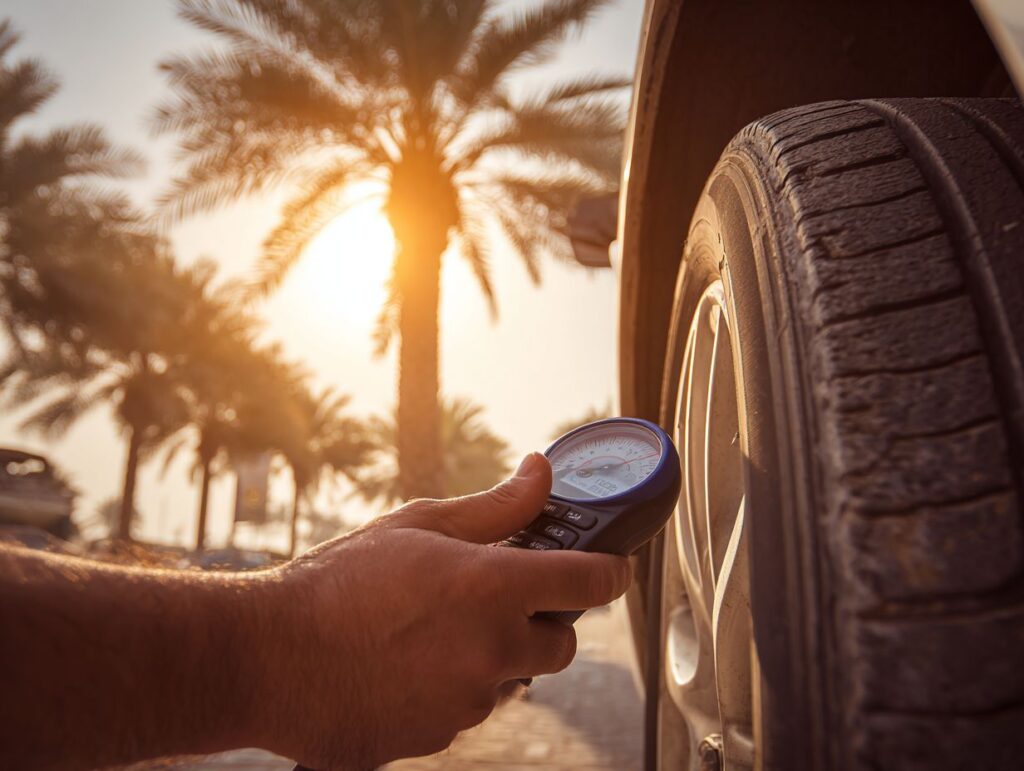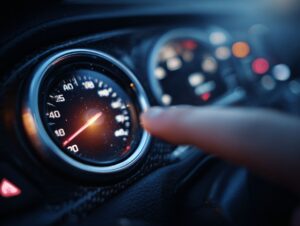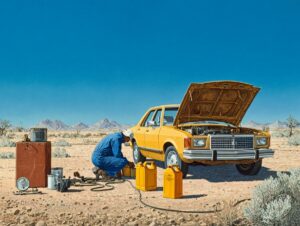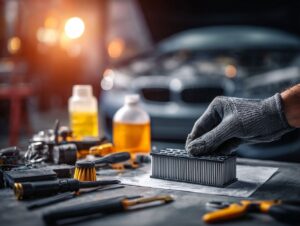In Dubai’s scorching summer, maintaining proper tyre pressure is crucial for safety, performance, and fuel economy. At 55 Car Garage—Al Quoz’s premier Dubai Car Garage and the Biggest Car Garage UAE with a 90,000 sq. ft. state-of-the-art facility—our ASE-certified team led by Masood and Vikas Anand utilizes advanced TPMS calibration and Hunter wheel alignment equipment to keep your luxury vehicle running optimally under extreme heat. This guide walks you through every step of checking, adjusting, and monitoring tyre pressure in temperatures that often exceed 50 °C.
- High ambient temperatures can increase tyre pressure by roughly 1 PSI for every 10 °F rise—regular checks are essential.
- Always measure pressure on cold tyres using a reliable digital gauge and adjust to the manufacturer’s recommended PSI.
- Leverage 55 Car Garage’s expertise, modern TPMS tools, and wheel alignment services to maintain optimal pressure in extreme conditions.
Why is Tyre Pressure Important in UAE Weather?
The UAE’s relentless heat places extra stress on tyres: as air heats up, it expands, raising internal pressure. Overinflated tyres lose their optimal contact patch, reducing grip and increasing the risk of blowouts, while underinflated tyres generate excess heat through sidewall flexing, leading to premature wear.
Both scenarios compromise handling, braking distances, and fuel efficiency. In harsh summer months, maintaining the correct pressure is not just preventive maintenance—it’s a safety imperative.
Impact of High Temperatures on Tyre Pressure
For every 10 °F (≈5.5 °C) increase in ambient temperature, tyre pressure can rise by approximately 1 PSI. On days when thermometer readings approach 50 °C, your tyres may become dangerously overinflated if left unchecked. Such overpressure can cause uneven tread wear in the center, reduced braking performance, and a higher likelihood of blowouts at high speeds. Conversely, if your tyres cool down after a drive, pressure can drop, risking underinflation and additional heat buildup. A monthly check and pre-trip inspection are your best defenses.
How to Check Tyre Pressure Correctly?
Accurate tyre pressure measurement hinges on proper timing, tools, and technique. Follow these guidelines to ensure you get reliable readings every time, even amid Dubai’s temperature swings.
1. Tools Needed for Accurate Measurement
Invest in a quality tyre pressure gauge—digital models (AED 75–185) offer precise, backlit displays and rapid response, while analog gauges (AED 40–110) are maintenance-free and battery-less. Ensure your gauge is calibrated annually. You’ll also need an air compressor—available at service stations or in our facility—to add air, and a small valve-core tool (or flat-head screwdriver) to release excess pressure.
2. Step-by-Step Guide to Checking
- Cold Tyre Check: Park the vehicle in shade and wait at least 30 minutes after driving. Cold tyres give the most accurate baseline pressure.
- Locate Recommended PSI: Refer to the placard on the driver’s door jamb or your owner’s manual for front/rear specifications.
- Measure Pressure: Remove the valve cap, press the gauge squarely onto the stem, and read the value. Repeat twice per tyre for consistency.
- Record & Compare: Log each tyre’s PSI and compare against the recommended range. Document readings to identify any gradual leaks.
What is the Recommended Tyre Pressure for Your Vehicle?
Tyre pressure varies by make, model, and load. As a general guideline:
- Sedans: 30–35 PSI
- SUVs/Crossovers: 32–40 PSI
- High-performance/Sports cars: 35–45 PSI
Always default to the manufacturer’s exact figures on the driver’s door frame. Adjust upward by 1 PSI for each additional passenger or heavy cargo load, and recheck after any change to confirm accuracy.
How to Adjust Tyre Pressure in Hot Weather?
Maintaining ideal pressure in high heat requires both adding and releasing air precisely. Follow these steps to avoid overcorrection:
Steps for Releasing or Adding Air
Adding Air: Connect an air compressor nozzle firmly to the valve stem. Inflate in 2–3 second bursts, checking pressure after each burst until you reach the target PSI. The entire process takes 5–10 minutes per tyre at most service stations or at our shop.
Releasing Air: Depress the valve-core pin gently with a small tool until the gauge reads your desired PSI. Release in short increments, rechecking frequently to prevent underinflation. Always replace valve caps to keep dirt and moisture out.
What are the Signs of Incorrect Tyre Pressure?
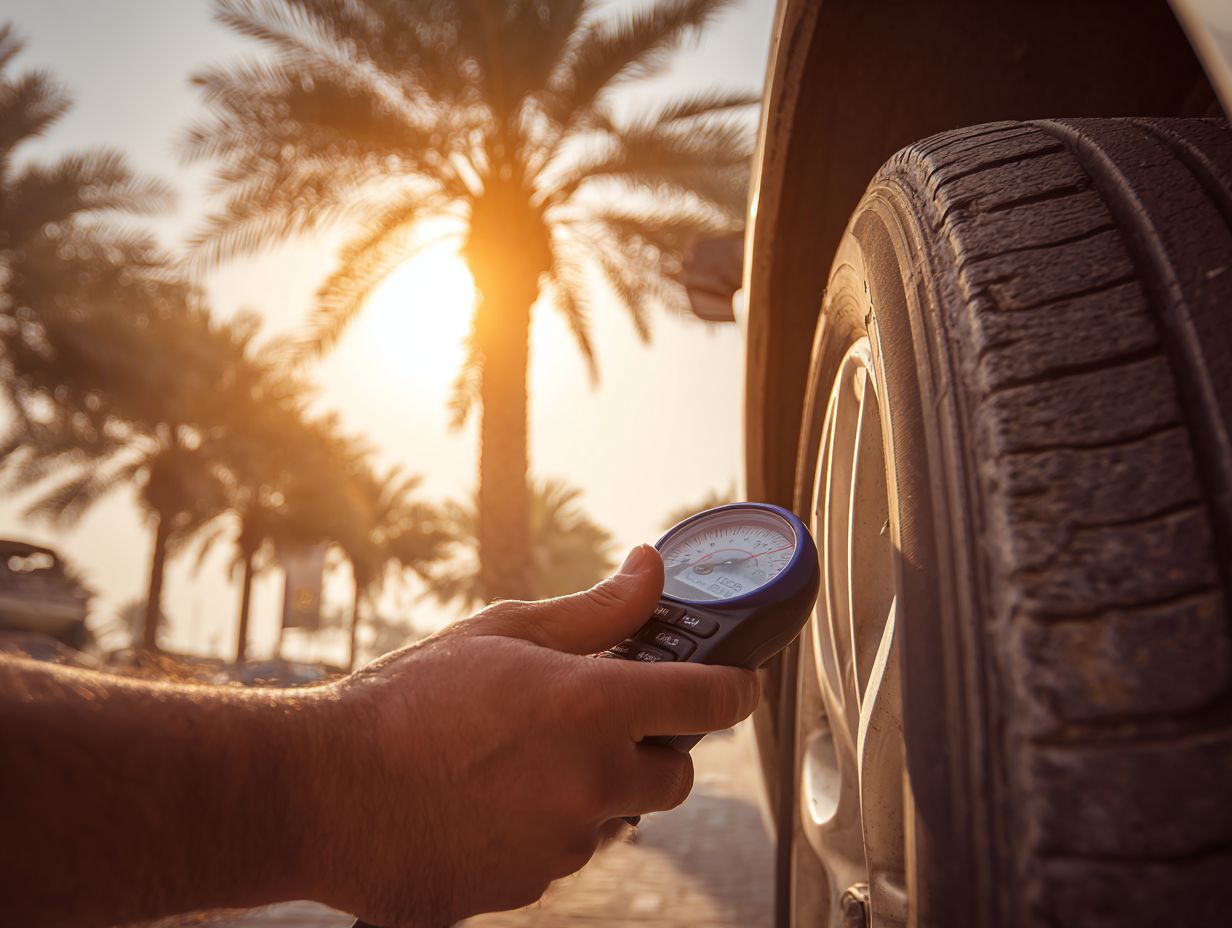
Failing to maintain proper tyre pressure manifests in several ways:
- Uneven Tread Wear: Center-only wear signals overinflation; edge-only wear points to underinflation.
- Frequent Blowouts: Excess pressure can rupture sidewalls, especially on hot asphalt.
- Decreased Fuel Efficiency: Underinflated tyres increase rolling resistance, hiking fuel consumption.
- Poor Handling: Incorrect pressure affects steering precision and braking response in emergency maneuvers.
How Can You Maintain Optimal Tyre Pressure in Extreme Conditions?
Proactive monitoring and climate-adapted adjustments are key. Check your tyres monthly and before any long drive. Use a gauge like the AstroAI Digital Tire Pressure Gauge for fast readings, and carry a portable compressor—such as the TireWell model—for on-the-go tweaks. Remember to add roughly 1 PSI for every 10 °F increase above standard ambient conditions to offset heat expansion.
Best Practices for Tyre Maintenance in UAE
Regular Checks and Seasonal Adjustments
Establish a routine: inspect pressure every two weeks, and perform a thorough check at the start of summer and winter. Record readings in a maintenance log to spot slow leaks early. Calendar reminders ensure you never skip these vital inspections.
Common Mistakes to Avoid When Checking Tyre Pressure
- Hot Tyre Measurements: Never check immediately after driving—wait 30 minutes for accurate cold PSI.
- Ignoring the Spare: A flat spare tyre can strand you—include it in your monthly routine.
- Damaged Valves: Inspect stems and caps for cracks or corrosion to prevent slow leaks.
- Uncalibrated Gauges: Replace or recalibrate gauges annually to maintain accuracy.
How to Find Professional Help for Tyre Issues?
When in doubt, consult experts who understand UAE’s unique driving environment. 55 Car Garage offers end-to-end tyre services tailored for luxury vehicles:
Services Offered by 55 Car Garage
- Comprehensive Tyre Inspections: Tread depth, sidewall integrity, and air-leak diagnostics.
- Suspension Repair Integration: Correct alignment to prevent uneven wear.
- State-of-the-Art TPMS Calibration: Factory-level sensor programming for real-time monitoring.
- Professional Rotation & Balancing: Utilising Hunter Road Force balancing to eliminate vibrations.
- Full Mechanical Services: Oil changes, brake checks, and preventive maintenance under one roof.
Why Choose 55 Car Garage for Tyre Maintenance?
Selecting 55 Car Garage means entrusting your vehicle to the largest facility in the Middle East. With a 90,000 sq. ft. center, ASE-certified technicians, and cutting-edge equipment, we deliver unmatched accuracy and reliability. Enjoy a free tyre inspection with every service and access to premium brands like Michelin and Pirelli.
Expertise and Equipment at 55 Car Garage
Our team holds advanced certifications and undergoes continuous training in climate-adapted maintenance. We leverage:
- Hunter Road Force Wheel Balancer for pinpoint vibration detection.
- Professional TPMS tools to read and reset manufacturers’ sensors.
- Industrial-grade compressors and digital gauges for precise inflation.
- Comprehensive alignment racks to optimize handling and tyre life.
Frequently Asked Questions
1. How do I check tyre pressure correctly in UAE weather conditions?
Ensure your tyres are cold (parked for 30 minutes), locate the recommended PSI on the driver’s door jamb, then measure with a calibrated gauge, taking two readings per tyre for consistency.
2. What is the recommended tyre pressure for UAE weather conditions?
Refer to your vehicle placard: typically 30–35 PSI for sedans, 32–40 PSI for SUVs, and 35–45 PSI for performance cars. Adjust by ±1 PSI per 10 °F deviation.
3. How often should I check my tyre pressure in UAE weather conditions?
Monthly checks are the minimum; bi-weekly or pre-trip inspections are recommended during peak summer heat.
4. What are the consequences of driving with incorrect tyre pressure in UAE weather conditions?
Improper PSI leads to reduced grip, uneven wear, higher fuel bills, and a greater risk of blowouts—especially on hot asphalt.
5. Can I use the tyre pressure listed on my vehicle’s manual for UAE weather conditions?
Yes—use the manual’s values as a baseline, then factor in temperature adjustments. When in doubt, visit 55 Car Garage for an expert check.
6. Can I rely on 55 Car Garage for tyre pressure checks and repairs in UAE weather conditions?
Absolutely. As Dubai’s leading luxury Car Garage Dubai, we combine expertise, cutting-edge tools, and climate-specific solutions to keep you safe and efficient on the road. Book your comprehensive service or inquire about fleet maintenance today.

